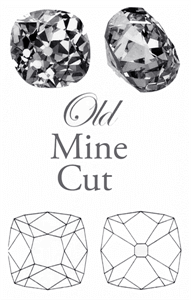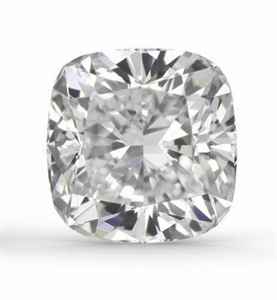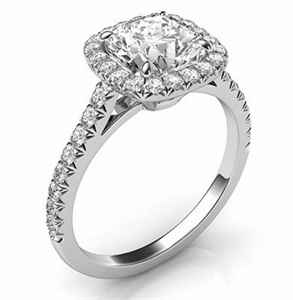The cushion cut is currently one of the most popular cuts in non-round diamonds.Loved for its un traditional shape and classic vibe, cushion cut diamonds have become a hot pick for engagement rings and vintage-styles rings. Discovered some 200 years before, the cushion cut predates most other diamond cuts. Its antiquity is obvious even in the evolved version of the cut we see today.
A brilliant cut like Round, Oval, Pear, Radiant and the Marquise, it shares most of the burning fire of the two most popular cuts of all times. Often set with halo, the cushion cut is often sighted in rings both modern and vintage-inspired. The one thing that makes the cut so easily likeable is its timeless aesthetics that fit any fashion context without having to try. It has everything suiting the modern requirements and a charm that closely linked tothe old world. Sophisticated and elegant, the cushion cuts are great towear on any finger.
The ABCs of Cushion Cut
Any discussion about a diamond cut is incomplete without a little introduction tothe cut. Although cushion cut is one of those cuts that require little introduction, some basic technicalities are still missing from people general knowledge of it. So, to touch those up briefly, here are some basic details.
The modern cushion cut is a brilliant cut, but it has not always been so. The cushion cut originated from the old mine cut which has far fewer facets and therefore, lesser brilliance. Cushion cut as we know it today is a curvier version of the old mine cut (Picture 1).

Picture 1: Old Mine cut diamond,pictures and plots
The cushion cut got its name from its shape which a soft square, something close toa pillow. The pillowy shape of cushion cut is not always square. Some cushion cuts are even rectangular, while others have shapes between a square and arectangle.
Speaking of shape, a cushion cut has a certain size advantage, which other brillian cuts do not have. Having visibly large facets, a cushion cut diamond appears slightly larger than other shaped stones of similar carat. When viewed from the top, the spready table creates an illusion of largeness which round cut gems fail to produce.
That however does not affect the price of a cushion cut. So, to answer the most frequently asked question, cushion cuts are cheaper than the traditional brilliant cuts such as round and Ovals. To give you a little perspective, a cushion cut costs somewhere between 25 to 50% of the price of a round brilliant cut diamond. So, expect to save at least a good deal by choosing acushion (Picture 2) instead of the other brilliant cut stones.

Picture 2: The modern Cushion cut diamond picture
A growing popularity of cushions are affecting the price mildly. In its entire tenure of existence, the cushion cut has been phenomenally popular on two occasions- in the first 100 years of its existence, and at this present moment when fancy cut gems are rising to popularity toppling traditional cut stones from their top positions.
Cushion cut stones are loved by women of all ages and with varying tastes in jewelry for two main reasons- first because no other cut retains the color of a diamond like a cushion cut, and second, it’s tops all other cuts when it comes to matching with a halo settings (Picture 3). So, if your dilemma is between a cushion cut and any other brilliant cut, if price is a priority because you will have won big from making the choice, money aside. Select Cushion diamonds by their 4 C’s at Diamonds-usa.com.

Picture 3: Cushion cut diamond halo engagement ring
The Evaluation Chart
So there is an evaluation chart for cushions that yields significantly better results as far as assessment is considered than most unstandardized ones. So, here is how to best evaluate a cushion diamond.
The Anatomy of the Cut
You know it’s a great cut when you see symmetrical proportions and you know it’s a poor cut when it’s not. Luckily for you, there is such a thing as ideal proportions in cushion cut that can guide you through the clutter of measurements and proportions.
There are basically five characters in a cut that make all the difference- the depth, table, crown, culet and girdle. Find them in the diamond’s certificate and the vendor. An excellent cut is one that has depth ranging between 61.1 to 67%, table between 61 and 67.9%, crown between 8 to 16%, no culet and a thin to gently thick girdle. So if there is anything as the ideal proportion in a cushion cut, that would be it.
However, if you can make do with anything lesser than that, then a good cut is what you should aim for. A good cushion cut is one that has depth of 56-58 to 70-72%, a table between 56 to 57.2 and 69- 72%, a culet which is slightly large and a girdle which is very thin, but never too thick.
Evaluating the Color
Once you have the measurements sorted out, what remains to check is the color of the stone. Before we begin, let me tell you that color is a highly subjective thing in cushion cut diamonds. In the color spectrum, G to I in diamonds are the warmer shapes whereas D to F is the colorless zone. To expound on that with some specificity, here are the bars.
For a stone lesser than .50 carat, anything between I and K is good and D and G excellent.
Stones over .50 carat but below 1.0 carat look good in color I and excellent in shades between D and G.
For bigger carats like 1.0 to 2.0, the preferred color is G for a good stone and D to F for an excellent one.
For anything above 2.0 carats, you have to go slightly higher up because larger stones are visibly more revealing than smaller ones. For such a size of diamond, you want to pick something between G and H for a good looking stone and D and F for an excellent one.
Selecting a Clarity
Clarity is another important thing to consider in a cushion cut gem. Each buyer has a different standard in clarity. So, without interfering with your choice, here are some set numbers for good and excellent clarity stones.
Starting with stones below 0.50 carat, you want to pick anything between I1 and I2 for a good stone and FL and VSI for an excellent one. The grades are SI2 for a good stone and FL to VS1 for stones below 1.0 carat. For stones below 2 carats and above, SI1 to SI2 is a good range. But for an excellent pick you need to choose from FL to VS1 for stones below 2 carats and FL to VVS2 for stones over 2 carat. Always ask the vendor whether the diamond is eye clean
Essential Tips of Picking
· The first trick to picking an excellent cushion is to identify the ideal ratio. That can be different for different buyers. Do you want your cushion to be a uniform square or anything rectangular is preferable for you. Once you are decided on that, the rest is simple. For square, you want something between 1.00 and 1.05 which is like about the best proportions in a square. As for a rectangular cut, you want something between 1.15 and 1.5 for an ideal proportion. The difference, you will see is pretty visible.
· When it comes to quality, most people stumble to put in words what makes a good cut. Qualitatively speaking, an excellent cut is one that says excellent. Similarly, a Very Good cut is one that’s graded so. That reduces the confusion by a good measure. To make sure that you are picking a particularly well-proportioned and symmetrical cushion, make your choice from Excellent and Very Good grades.
· Facets is one of the most confusing aspects of a cut. What makes a stone maximally sparkling? More or fewer facets? An easy answer to that is more. The old mine cut had fewer faces and therefore, lesser brilliance. Ideally, for a cushion, you want 58 facets. Although the numbers vary from diamond to diamond, anything in the neighborhood of 58 warranties maximum brilliance.
· Color is common in cushion cut gems. Has that got you wondering why? It’s because a cushion diamond retains all of its natural color and shows it too. So, that’s why cushion cut is recommended to those whose preference is colored gems. Currently, the market is spilling with colored gems that include a rich variety of colored diamonds especially the Canary Yellow.
What You Want to Avoid
One thing that you gets in the way of getting the best return for an investment such as this is a bad cut. Ideally, to avoid this misstep one must know how to identify a poor cut. This may involve some scoping, but easily without a jeweler’s tools. Look for symmetry in your cushion cut diamond. Draw an imaginary line through the center of the cut and see if the two halves match like they are part of the same structure. Check the proportions and see if the cut really enhances the color of the stone or does it inversely dull it. That’s how you can tell if you are looking at a poorly cut stone or not.
***